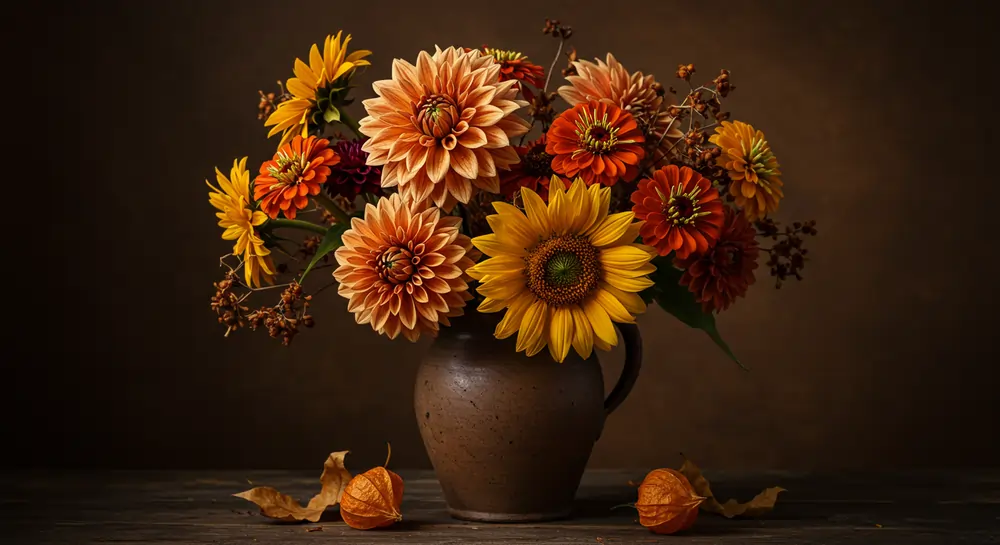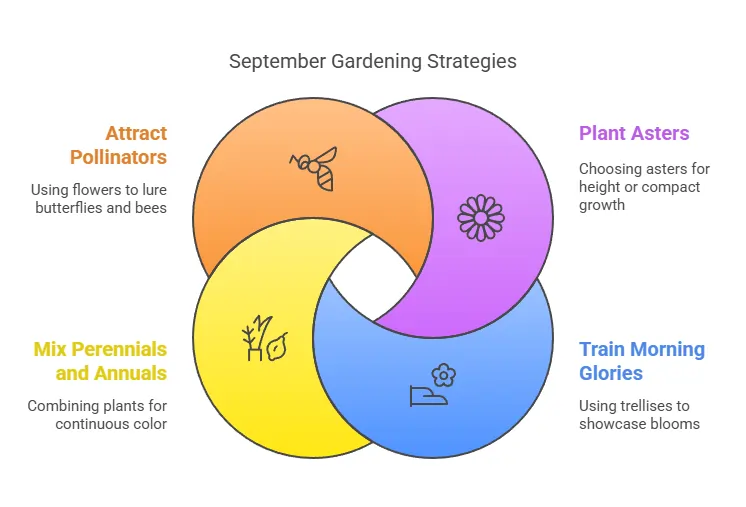Introduction: The Charm of September Flowers
As summer’s warmth gives way to the crisp embrace of early autumn, gardens and florists alike burst into a symphony of color. September is a month of transitions, and its flowers in September reflect this beautifully—balancing the vibrant energy of late summer with the muted elegance of fall. At the heart of this floral tapestry are two stars: the aster and morning glory, the official September birth month flowers. But they’re not alone! From dahlias in warm jewel tones to chrysanthemums that brighten fading gardens, this month offers a kaleidoscope of flowers available to inspire bouquets and arrangements, wedding flower designs, or simply a garden in September that refuses to quit.
In this guide, we’ll dive into the meaning behind September’s blooms, explore their rich histories, and share tips for incorporating them into your life—whether you’re a September birth celebrant, a gardener, or a florist crafting floral arrangements for an end of September soirée. Let’s begin with the month’s iconic duo: aster and the morning glory.
The Aster: A Starry Symbol of Love and Resilience

The aster flower, with its daisy-like flowers and vibrant blooms, is a true showstopper. Its name comes from the Greek word “astron,” meaning “star”—a nod to its petals radiating like celestial bodies around a central disk surrounded by delicate florets. But there’s more to this pretty flower than meets the eye.
Mythology and Meaning
According to Greek legend, asters were born from the tears of the goddess Astraea. Distraught by humanity’s greed, she wept, and where her tears hit the ground, turned into asters as a symbol of hope and purity. This lore cements the aster’s association with new beginnings, love, and wisdom.
- Color Symbolism:
- Purple flowers: Wisdom and royalty
- White flowers: Innocence and purity
- Pink shades: Sensitivity and affection
Gardening and Uses
Asters thrive in late summer and early fall, making them perfect for autumn flowers displays. They’re part of the Asteraceae family (which includes sunflowers and daisies) and attract pollinators like bees with their nectar-rich blooms. Popular varieties include New England asters, known for their hot pink flowers and towering stems.
Pro Tip: Pair asters with rudbeckia or chrysanthemum for a garden that brightens as temperatures drop.
Morning Glory: The Ephemeral Emblem of Affection
If the aster is the steadfast star, the morning glory is the fleeting poet. These trumpet-shaped blooms open at dawn and close by afternoon, symbolizing the transient beauty of life and love. Their name says it all—morning glory species are a daily reminder to cherish each moment.
Cultural Significance
In Victorian times, morning glories represented undying devotion, but their short lifespan also hinted at unrequited love. In Japan, they’re celebrated in art and festivals, while Chinese folklore ties them to a tale of lovers separated by the gods.
- Color Meanings:
- Blue flowers: Peace and serenity
- Purple: Spirituality and enchantment
- White: Purity and new beginnings
Growing Morning Glories
These annual or perennial vines (depending on climate) are fast growers, often scaling trellises with lance-shaped foliage. They bloom from early summer through frost, offering tubular flowers in blue and purple, shades of pink, and even yellow flower varieties like ‘Moonflower’.
Caution: Some species, like Ipomoea tricolor, have hallucinogenic seeds—keep them away from pets and kids!
Aster vs. Morning Glory: A Side-by-Side Comparison
The aster and morning glory species offer vibrant choices for gardens, especially since both are available in September. Asters provide a wide range of colors, ranging from white to purple, and belong to the daisy family. In contrast, morning glory flowers are trumpet-shaped and come in a variety of colours.
September has two birth flowers, and both asters were named after a Greek legend telling the story of a goddess. These flowers guide garden enthusiasts with flower ideas. While many flowers bloom, flowers open like the lily inspire wonder and delight, making them a perfect choice for any garden.
To help you choose between these September birth flowers, here’s a quick guide:
| Feature | Aster | Morning Glory |
|---|---|---|
| Symbolism | Love, wisdom, resilience | Affection, fleeting beauty |
| Bloom Time | Late summer and early autumn | Dawn to midday; summer through fall |
| Colors | Purple, white, pink, blue | Blue, purple, pink, white, red |
| Growth Habit | Bushy perennial | Climbing vine |
| Best For | Floral arrangements, pollinator gardens | Trellises, symbolic gifts |
Beyond Birth Flowers: Other September Blooms to Love
While asters and morning glories steal the spotlight, September’s palette includes:
- Dahlias: Daisy-like in structure but bolder, with hot pink flowers and warm jewel tones.
- Chrysanthemums: A fall staple, symbolizing joy and longevity.
- Hydrangea: Their blue flowers or shades of pink fade beautifully into autumn.
- Gypsophila (Baby’s Breath): Adds dainty texture to wedding flower arrangements.
- Sunflowers: Their yellow flower heads evoke late-summer warmth.
Pro Arrangement Idea: Combine asters with alstroemeria flower and freesia for a textured, fragrant bouquet.
Read Also https://ahouseinthevalley.com/polyurea-garage-floor-coating/
September Weddings: Blooms with Meaning
For couples marrying in September, the aster and morning glory offer rich symbolism. Purple asters add regal elegance to centerpieces, while white flowers like gypsophila and hydrangea evoke purity. Morning glories woven into arches symbolize love that renews daily—perfect for a September wedding flowers theme.
Tip: Pair with eryngium (sea holly) for metallic accents or verbena for cascading color.
Gardening in September: Tips for a Vibrant Display

- Plant Asters: Choose New England asters for height or Michaelmas daisies for compact growth.
- Train Morning Glories: Use trellises to showcase their trumpet-shaped blooms.
- Mix Perennials and Annuals: Combine rudbeckia (perennial) with annual verbena for continuous color.
- Attract Pollinators: Asters’ nectar lures butterflies, while sunflowers draw bees.
Conclusion: Embracing September’s Fleeting Beauty
From the story of how they got their names to their roles in warding off evil spirits (thanks, aster smoke!), September’s flowers are as rich in history as they are in hue. Whether you’re gifting September birth month flowers, designing a garden in September, or simply savoring the last vibrant blooms of the year, let these blossoms remind you to find magic in transitions—just like the tears of the goddess Astraea that became stars on Earth.
Final Thought: As the leaves and flowers of autumn take center stage, remember: even in September, nature’s poetry is everywhere.

Comments are closed.